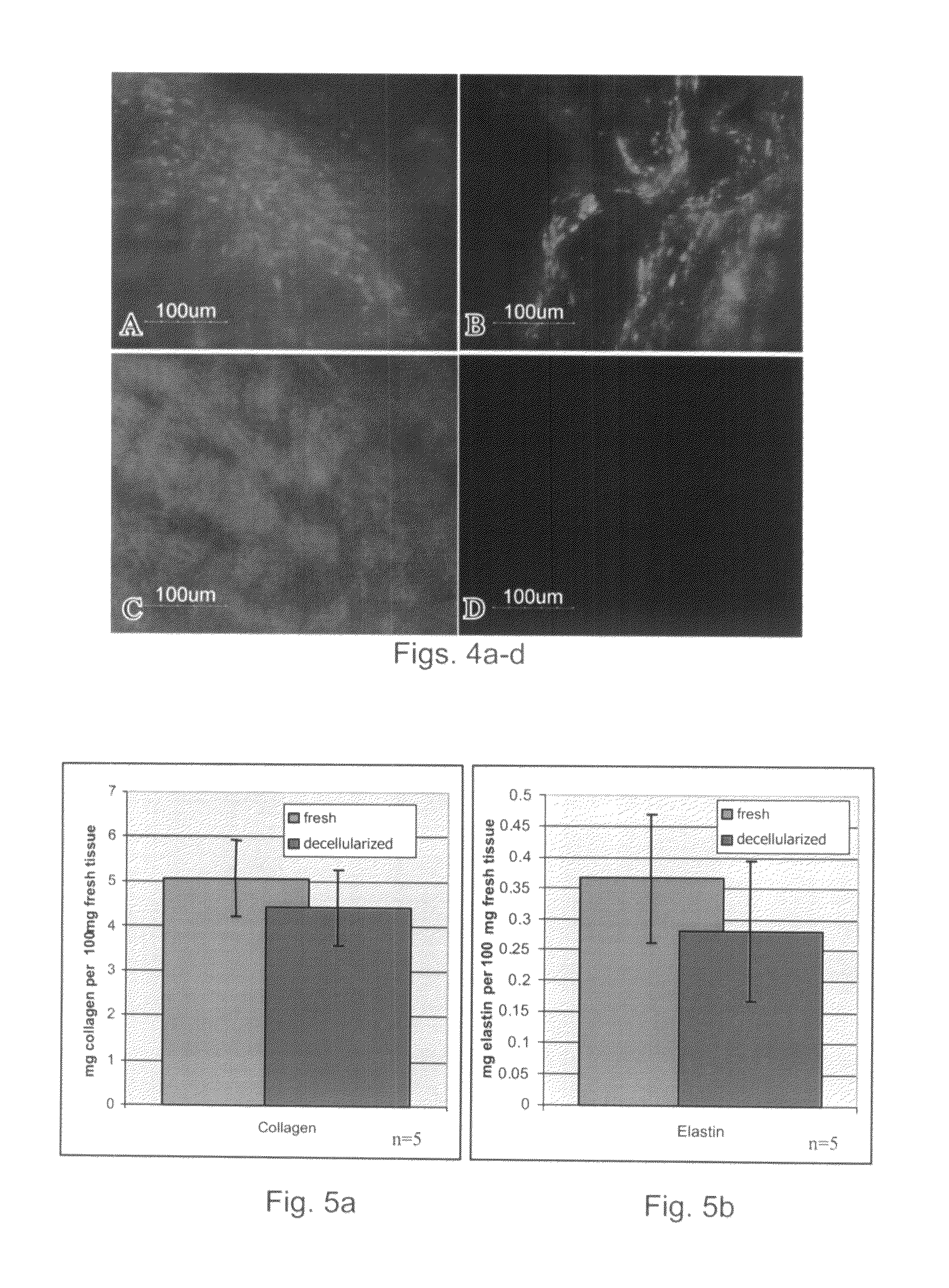Natural tissue-derived decellularized matrix and methods of generating and using same
a decellularized matrix and natural tissue technology, applied in the field of natural tissue-derived decellularized matrix and methods of generating and using same, can solve the problems of reducing the number of vascular grafts, unable to develop narrower vascular grafts, and unable to report ideal cardiac tissue equivalents
- Summary
- Abstract
- Description
- Claims
- Application Information
AI Technical Summary
Benefits of technology
Problems solved by technology
Method used
Image
Examples
example 1
Decellularization of Myocardium-Derived ECM and Assessment of the Decellularized Matrix
[0140]Cellular components are the main cause for immune responses against xenografts, therefore, for tissue regeneration and / or repair, tissue-derived decellularized matrices must be devoid of all cellular components. Prior art studies have suggested that removal of cellular components can be effected by digesting the tissues with proteases such as trypsin. However, excess enzymatic digestion might ultimately result, in undesired damage to the ECM structure, strength and elasticity. Thus, to obtain a tissue-derived decellularized matrix devoid of all cellular components yet capable of exhibiting the mechanical properties desired for such tissue constructs, the present inventors have devised, after laborious experimentations, the following efficient and well-calibrated decellularization protocol.
[0141]Materials and Experimental Methods
[0142]Dissection of myocardium tissues—Hearts of adult male and ...
example 2
Assessment of Acellularized Matrix Components and Mechanical Properties
[0163]To assess the suitability of the myocardium-derived decellularized matrix of the present invention as a scaffold for tissue regeneration, the present inventors have quantified the amount of collagen, elastin and glycosaminoglycans (GAGs) in the matrices and evaluated the structural and mechanical properties of the decellular matrices, as follows.
[0164]Materials and Experimental Methods
[0165]Collagen quantification—The content of collagen in the decellularized matrix was quantified using the hydroxyprolin assay with slight modifications (Neuman, R. & Logan, M., 1950). Briefly, matrix was hydrolyzed (7N HCl, 105° C., 16-20 hours), diluted and brought to pH=6. Free hydroxyprolin (Fluka, Switzerland) is oxidized to a pyrrole by chloramine T (in Acetate-Citrate buffer pH=6) and the reaction is followed by the pink color resultant of the pyrrole intermediate when reacted with 4-dimethylaminobenzaldehyde (in perch...
example 3
The Myocardium-Derived Decellularized Matrices are Suitable Scaffolds for Tissue Regeneration
[0177]To evaluate the suitability of the myocardium-derived decellular matrices as scaffolds for cardiac tissue engineering, the decellular matrices were tested for their ability to support the attachment, morphology and long-term viability of different types of cells including cardiac muscle, fibroblast and endothelial cells, as follows.
[0178]Materials and Experimental Methods
[0179]Isolation of cardiac fibroblasts—Cardiac fibroblasts were isolated from an adult sheep heart. Briefly, heart tissue was diced to ˜1 mm3 segments that were washed in sterile PBS and placed in culture plates without medium. After 10-12 minutes the medium was slowly added to the plates (DMEM with 10% FCS, Gibco) and the tissue segments were incubated untouched for one week (37° C., 5% CO2, humidified atmosphere) before first passage. These primary cardiac fibroblasts were split 1 / 8 with 0.05% Trypsin-0.02% EDTA, and...
PUM
| Property | Measurement | Unit |
|---|---|---|
| thick | aaaaa | aaaaa |
| internal diameter | aaaaa | aaaaa |
| size | aaaaa | aaaaa |
Abstract
Description
Claims
Application Information
 Login to View More
Login to View More - R&D
- Intellectual Property
- Life Sciences
- Materials
- Tech Scout
- Unparalleled Data Quality
- Higher Quality Content
- 60% Fewer Hallucinations
Browse by: Latest US Patents, China's latest patents, Technical Efficacy Thesaurus, Application Domain, Technology Topic, Popular Technical Reports.
© 2025 PatSnap. All rights reserved.Legal|Privacy policy|Modern Slavery Act Transparency Statement|Sitemap|About US| Contact US: help@patsnap.com



